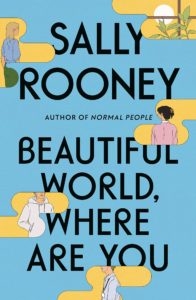At the age of 30, the Irish author has been noted for her insightful dissection of human bonds, delving especially into the chiaroscuro of love, the power of friendship, and the sensitive world of intimacy and sexuality. Rooney herself has repeatedly acknowledged that the main driving force behind her work is modern romantic relationships, saying “I find myself consistently drawn to writing about intimacy, and the way we construct one another”.

Rooney’s third novel, Beautiful World, Where Are You, raises the central theme from its very title: can people find authentic beauty in a world that seems increasingly chaotic and unviable? Evidently, the phrase contains a certain disenchantment with respect to contemporary life, possibly enclosing a form of deep nostalgia for other times. It is noteworthy that this text takes its title from a poem by Friedrich Schiller.
Beautiful World, Where Are You follows Alice Kelleher and Eileen Lydon, two Irish friends with a strong bond formed in college days. Although their relationship is sincere and heartfelt, Alice and Eileen live in different cities and have grown apart over time. Alice has become a wealthy and world-famous novelist, while Eileen has resigned herself to working at a small but prestigious literary magazine.
The book focuses essentially on the amicable relationship between Alice and Eileen, their respective love interests, and their countless missteps as they approach their thirties.
The fiction begins just after Alice moves to a small coastal town in County Mayo. After suffering a nervous breakdown and spending time in a psychiatric institution, Alice leaves New York City and moves to the Irish countryside seeking to get away from the media attention. There she meets Felix Brady, a working-class man who has little interest in art and literature. Felix is a local warehouse worker and leads a much more modest and ordinary existence.
Perhaps by whim, perhaps by fate, Alice and Felix, begin an unlikely love affair.
At the same time, Eileen Lydon works for a literary publication in Dublin for a salary that barely makes ends meet. The text editor is recovering from a heartbreak and spends much of her time stalking her ex-boyfriend’s social networks. Although she is haunted by the thought of what might have been, Eileen seeks solace and romance in the arms of a childhood friend, Simon Costigan.
Eileen and Simon’s story is bittersweet, they have been moving towards and away from each other for years. They constantly attract and repel each other. They want to be together, but fear losing the friendship they have cultivated since they were very young. Simon, for his part, has become a handsome political consultant, a member of the Catholic Church, with a special inclination for the divine and the priesthood.
Similar to Conversations with Friends, this novel reflects the evolution of two couples: Alice Kelleher and Felix Brady, and Eileen Lydon and Simon Costigan. Much of the story is devoted to showing the nature of both romances: the ups and downs, the closeness, the insecurities, the moments of sexual intimacy, and the reconciliations.
It is noteworthy that the third-person narration of the novel alternates with e-mail exchanges between Alice and Eileen. The Irish friends keep in touch via the Internet, updating each other on what is going on in their lives both professionally and romantically. Through these e-mail exchanges, the author offers an intimate insight into the characters’ personalities, their feelings and their view of humanity. At first glance it can be seen that they are intelligent, cerebral young women with a deep existential dissatisfaction.
“You should know that our correspondence is my way of holding onto life, taking notes on it, and thereby preserving something of my – otherwise almost worthless, or even entirely worthless – existence on this rapidly degenerating planet”, Alice writes to Eileen in an e-mail.
Theories, witticisms and observations about the modern world come and go between Alice and Eileen. These messages bring to the novel amusing and often profound reflections on a variety of subjects, such as the Bronze Age, the collapse of human civilization, climate change, the commodification of art, organized religion, aesthetic beauty, the nature of literary fiction, the uncertainty of the future, and, of course, their lives. Thus, much of the book presents an intellectual friendship that invites reflection on urgent and banal issues of our time.
“We are standing in the last lighted room before the darkness,” says Alice, given that “there is no chance for the planet, and no chance for us.”
And though Eileen agrees, she finds solace in the ordinary.
“Maybe we are just born to love and worry about the people we know,” she replies. “In fact it’s the very reason I root for us to survive – because we are so stupid about each other.”
The quartet in Beautiful World, Where Are You clearly reflects the angst of their time and the characteristics of their environment. In a way, there is a certain air of frustration, emptiness and failure in the lives of Alice, Eileen, Simon and Felix. All the characters feel useless or helpless at some point in the story, and as a result, the reader comes to wonder whether this problem is due to a specific circumstance of the plot, or rather, to a fixed condition of being human.
It is fair to say that the central male characters, Felix Brady and Simon Costigan have enormous dramatic potential. However, they never become fully developed personalities in comparison to Alice and Eileen. Although each has a decisive role in the story, there is a sense that their stories could have been explored more forcefully.
Towards the end of the book, the awaited meeting between the friends and their romantic partners takes place. Alice, Eileen, Simon and Felix share a few days in the novelist’s gigantic house. They eat together, party, and chat until late at night. Everything flows normally, until Alice and Eileen stir up old wounds and tell each other painful truths. Soon, the reunion turns bitter and illusions are dashed.
At this point in the book, the tension is essentially centered on how close people can hurt each other and yet still feel love in a deep way. The author makes it clear that pain is intrinsic to intimacy.
In this work, Sally Rooney resolutely searches for beauty in life and succeeds in finding it. Beautiful World, Where Are You is a sharp and witty novel that delves into universal and existential themes. On the one hand, it explores human connections, the fragility of love, emotional difficulties, and the complexity of adult relationships. On the other hand, it presents a conscientious look at the literary production system, unexpected fame, class stratification, and economic inequality. Beautiful World, Where Are You is the author’s most mature novel to date.
About Sally Rooney
Many literary critics call Sally Rooney the “novelist of the millennial generation”. She has been compared to writers as diverse as Jane Austen, Raymond Carver, and Karl Marx.
Her book Normal People was recognized with important distinctions, such as the Irish Book Award, the Costa Book Award, tand he Encore Award, as well as being adapted for television by the BBC. Although she is best known for her novels, Rooney is also the author of essays and short stories. Her writing has been published in outlets such as Granta, The New Yorker, The Dublin Review and The Stinging Fly. In 2017, Rooney won The Sunday Times Young Writer of the Year award.
Image: Priscilla Du Preez

